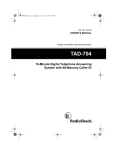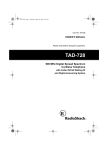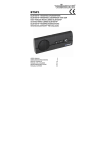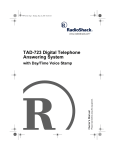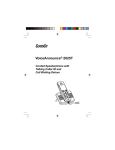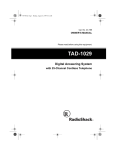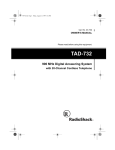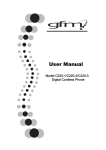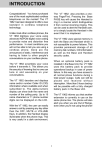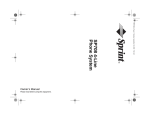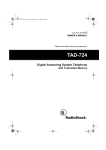Download Radio Shack TAD-705 Owner`s manual
Transcript
43-705.fm Page 1 Tuesday, May 23, 2000 8:54 AM TAD-705 12-Memory Speakerphone Please read before using this equipment. Owner’s Manual with 16-Minute Digital TAD and 62-Memory Caller ID 43-705.fm Page 2 Tuesday, May 23, 2000 8:54 AM ˆ Contents Features .................................................................................................................................. 5 Preparation ............................................................................................................................. 7 Installing a Backup Battery ................................................................................................ 7 Mounting the TAD ............................................................................................................. 7 On a Desk .................................................................................................................. 8 On a Wall or Wall Plate .............................................................................................. 8 Setting the Dialing Mode ................................................................................................... 9 Setting the Ringer ............................................................................................................. 9 Setting the Display Contrast .............................................................................................. 9 Setting the Long Distance Code ....................................................................................... 9 Setting the Area Code ....................................................................................................... 9 Setting the Day, Time and Date ...................................................................................... 10 Setting the Number of Rings ........................................................................................... 10 Telephone Operation ............................................................................................................ Switching Between the Handset and the Speakerphone ................................................ Adjusting the Volume ...................................................................................................... Using Redial .................................................................................................................... Using Flash ..................................................................................................................... Using Hold ....................................................................................................................... Using Privacy .................................................................................................................. Using Tone Services on a Pulse Line .............................................................................. Memory Dialing ............................................................................................................... Storing a Number in Memory ................................................................................... Storing Numbers from Caller ID Records ................................................................ Entering a Pause in a Memory Number ................................................................... Reviewing Memory Numbers ................................................................................... Dialing a Memory Number ....................................................................................... Chain-Dialing ........................................................................................................... Testing Stored Emergency Numbers ....................................................................... Connecting an Optional Headset .................................................................................... 11 11 11 12 12 12 12 12 12 13 13 13 13 14 14 14 14 TAD Operation ...................................................................................................................... Recording the Outgoing Messages ................................................................................. Checking the Outgoing Messages .................................................................................. Setting the TAD to Answer Calls ..................................................................................... Announce Only ........................................................................................................ Incoming Message Recording ......................................................................................... Playing Messages ........................................................................................................... Recording a Memo .......................................................................................................... Recording a Conversation ............................................................................................... Deleting Messages .......................................................................................................... Screening Calls ............................................................................................................... 15 15 15 15 16 16 16 17 17 18 18 © 2000 Tandy Corporation. All Rights Reserved. RadioShack and RadioShack.com are trademarks used by Tandy Corporation. 2 43-705.fm Page 3 Tuesday, May 23, 2000 8:54 AM Using Call Breakthrough ................................................................................................. Changing the CBT Code ......................................................................................... Changing the Remote Operation Security Code ............................................................ Remote Operation .......................................................................................................... Using the Toll-Saver ....................................................................................................... Using Remote Commands ............................................................................................. Remote Command List ............................................................................................ 18 18 19 19 19 19 19 Caller ID Operation .............................................................................................................. Caller ID Messages ........................................................................................................ Reviewing Caller ID Records .......................................................................................... Reviewing the Call Forwarding Information ............................................................. Deleting Call Records ..................................................................................................... Deleting a Single Call .............................................................................................. Deleting All Calls ..................................................................................................... VIP Call List .................................................................................................................... Marking a Call Record as a VIP Call Record .......................................................... Setting the VIP Alert ................................................................................................ Dialing Number Selections ...................................................................................... Using Dial ................................................................................................................ 21 22 22 23 23 23 23 23 23 24 24 24 Troubleshooting ................................................................................................................... 26 Resetting the TAD .......................................................................................................... 27 Care ................................................................................................................................ 27 WARNING: To reduce the risk of fire or shock hazard, do not expose this product to rain or moisture. CAUTION RISK OF ELECTRIC SHOCK. DO NOT OPEN. ! CAUTION: TO REDUCE THE RISK OF ELECTRIC SHOCK, DO NOT REMOVE COVER OR BACK. NO USER-SERVICEABLE PARTS INSIDE. REFER SERVICING TO QUALIFIED PERSONNEL. This symbol is intended to alert you to the presence of uninsulated dangerous voltage within the product’s enclosure that might be of sufficient magnitude to constitute a risk of electric shock. Do not open the product’s case. ! This symbol is intended to inform you that important operating and maintenance instructions are included in the literature accompanying this product. 3 43-705.fm Page 4 Tuesday, May 23, 2000 8:54 AM Your TAD (Telephone Answering Device) is ETL listed to UL standards and meets all applicable FCC standards. to your telephone company. These numbers are on the bottom of the base. Note: You must not connect your TAD to: IMPORTANT CALLER ID INFORMATION • coin-operated systems • party-line systems To use the TAD’s Caller ID, you must be in an area where Caller ID service is available, and you must subscribe to the service. Where Caller ID is offered, one or more of the following options are generally available: • caller's number only • caller's name only • caller's name and number Note: For the TAD’s Caller ID memory dial feature to operate, you must receive the caller's number. READ THIS BEFORE INSTALLATION We have designed your TAD to conform to federal regulations and you can connect it to most phone lines. However, each device that you connect to the TAD line draws power from the line. We refer to this power draw as the TAD's ringer equivalence number, or REN. The REN is shown on the bottom of your TAD. If you use more than one telephone or other device on the line, add up all the RENs. If the total is more than five (three in rural areas), your TAD might not ring. If ringer operation is impaired, remove one of the devices from the line. FCC STATEMENT Your TAD complies with Part 68 of FCC Rules. Upon request, you must provide the phone's FCC registration number and REN 4 • most electronic key phone systems THE FCC WANTS YOU TO KNOW In the unlikely event that your TAD causes problems on the phone line, the phone company can temporarily discontinue your service. If this happens, the phone company attempts to notify you in advance. If advance notice is not practical, the phone company notifies you as soon as possible and advises you of your right to file a complaint with the FCC. Also, the phone company can make changes to its lines, equipment, operations, or procedures that could affect the operation of this telephone. The telephone company notifies you of these changes in advance, so you can take the necessary steps to prevent interruption of your telephone service. LIGHTNING Your TAD has built-in protection circuits to reduce the risk of damage from surges in telephone line and power line current. These protection circuits meet or exceed the FCC requirements. However, lightning striking the telephone or power lines can damage your TAD. Lightning damage is not common. Nevertheless, if you live in an area that has severe electrical storms, we suggest that you unplug your TAD when storms approach to reduce the possibility of damage. 43-705.fm Page 5 Tuesday, May 23, 2000 8:54 AM ˆ Features Your RadioShack 12-Memory Speakerphone combines a speakerphone, a high-quality fully-digital answering system and a Caller ID unit in one system. The TAD (Telephone Answering Device) prevents you from missing incoming calls and messages. Fully digital means the TAD stores all messages on a computer chip — there are no tape mechanism to wear out and no tapes to bother with. This gives you capabilities that tape-based answering machine do not have. For example, you can listen quickly from message to message without listening to all of them. The TAD also shows the caller's telephone number (and name, if available in your area) and the current date and time, as provided by your local phone company to Caller ID service subscribers. It saves up to 62 Caller ID records that you can review and call back. Pause — lets you enter a pause for systems that require an access code (9, for example) before you dial an outside number. Redial — lets you quickly redial the last number dialed. Volume Control — lets you control the volume of the sound you hear through the handset, speakerphone, or headset. Adjustable Ringer Volume — lets you set the ringer to low or high, or even turn it off. Tone/Pulse Dialing — lets you use either type of service, and you can easily switch from pulse to tone dialing for long-distance, bank-by-phone, or other special services. Hearing-Aid Compatible — lets you use the telephone with hearing aids that have a T (telephone) switch. TELEPHONE FEATURES 12-Number Memory Dialing — lets you store up to 12 numbers in memory for easy dialing. Speakerphone — allows hands-free telephone conversation. Headset Jack — lets you connect an optional headset (available from your local RadioShack store) for hands-free convenience. Flash — sends an electronic switchhook signal for use with special phone services such as Call Waiting. Privacy — prevents the person on the phone from hearing your conversation with someone in the room. Hold — lets you put a call on hold. TAD FEATURES Dual Outgoing Messages — lets you record two outgoing messages of up to about 32 seconds each: one for when you want callers to leave a message, the other for when you want to play an announcement without recording callers' messages. Voice Date/Time Stamp — records the day and time each message was recorded. Two-Way Recording — lets you record both sides of your phone conversation. Memo Recording — lets you leave message for yourself or others in your home or office. Adjustable Ring Number — lets you set the TAD to answer after two, four, or seven rings. Features 5 43-705.fm Page 6 Tuesday, May 23, 2000 8:54 AM Toll-Saver — lets you avoid unnecessary toll charges when you call by long-distance to check your messages. Remote Operation — lets you use a touchtone phone (or rotary phone and pocket tone dialer) to operate the TAD and Caller ID while you are away from your home or office. Phone Pick-Up Detection — stops recording when you pick up any phone on the same line as the TAD. Call Breakthrough (CBT) with Programmable Code — alerts you to an important call when the caller enters a preset code during the outgoing message. Call Screen — lets you listen when a caller leaves a message so you can decide whether or not to answer the call. Programmable Remote Operation Security Code — lets you set your own security code for remote operation. Remote Answer-On — lets you turn on the TAD from a remote location even when it is not set to answer calls. VIP Call List — lets you save up to 10 caller ID records in a VIP list. Then, when any of those callers call, the TAD sounds a distinctive tone. Call Summary — displays the number of calls you received. New Call Indicator — lets you see at a glance that you have new calls. Review Scrolling — lets you easily scroll through all records in Caller ID memory. Dialing Option — lets you select the usable dialing number from the Caller ID record to match the different telephone systems. DIAL — lets you dial the phone number in a Caller ID record with the touch of a button. Message Waiting — lets you know that you have received a voice mail message (if you subscribe to a message waiting service from your local telephone company). Contrast Control — lets you adjust the display contrast for the best readability. Room Monitor — lets you listen from a remote phone to the room where the TAD is installed. Memory Backup — protects messages stored in memory in case of a power failure. CALLER ID FEATURES 3-Line Display — lets you view an entire Caller ID record on one screen. Caller ID Memory — stores up to 62 Caller ID records with name and number or name only, depending on the information your phone company provides. 6 Features 43-705.fm Page 7 Tuesday, May 23, 2000 8:54 AM ˆ Preparation INSTALLING A BACKUP BATTERY Warning: Dispose of old batteries promptly and properly. Do not burn or bury them. You can install an optional 9V backup battery so if the AC power fails or you unplug the TAD, the TAD will save the messages, time and day settings, CBT and remote operation security codes, and Caller ID records. For the best performance and longest life, we recommend you use a RadioShack alkaline battery. Caution: If you do not plan to use the TAD for a month or longer, remove the battery. A battery can leak chemicals that can destroy electronic parts. Cautions: Use only a fresh battery of the required size and recommended type. 1. Use a Phillips screwdriver to remove the two screws on the battery compartment cover, then remove the cover. MOUNTING THE TAD You can place the TAD on a desk or table, mount it on a standard wall plate, or mount it directly on a wall. Select a location that is near both an AC outlet and a modular phone line jack. Notes: T LIF • Your TAD connects directly to a modular telephone line jack. If your phone line jack is not a modular jack, you can update the wiring yourself, using jacks and adapters available at your local RadioShack store. Or, you can let the phone company update the wiring for you. • The USOC number of the jack to be installed is RJ11C. 2. Snap the battery's contacts firmly onto the battery connector and place the battery in the compartment. Cautions: You must use a Class 2 power source that supplies 9V AC and delivers at least 400 mA. Its plug must fit the TAD's AC 9V 400mA jack. The supplied adapter meets these specifications. Using an adapter that does not meet these specifications could damage the TAD or the adapter. ! 3. Replace the cover and secure it with the two screws. Replace the battery when appears. Preparation 7 43-705.fm Page 8 Tuesday, May 23, 2000 8:54 AM • Always connect the AC adapter to the TAD before you connect it to AC power. When you finish, disconnect the adapter from AC power before you disconnect it from the TAD. On a Desk 1. Plug one end of the supplied long modular cord into the TEL. LINE jack on the back of the TAD, then plug the cord's other end into a modular phone line jack. 2. Plug the supplied AC adapter's barrel plug into the AC 9V 400mA jack on the back of the TAD, then plug the other end of the adapter into a standard AC outlet. 1. Plug the supplied short modular line cord into the TEL.LINE jack on the back of the TAD. 2. Insert the supplied AC adapter's barrel plug into the AC 9V 400 mA jack on the back of the base. 3. To mount the TAD on a wall plate, route the adapter cord hanging down and the other end of the short modular cord through the center of the bracket. Insert the tabs on the narrow end of the bracket into the slots on the bottom of the base, then push the tab on the wide end of the bracket into the lower slots on the bottom of the base. Plug the short modular cord's other end into the wall plate jack, align the base's keyhole slots with the wall plate studs, and slide the base downward to secure it. To mount the TAD directly on a wall, with the power cord and the long modular cords hanging down, insert the tabs on the narrow end of the bracket into the slots on the bottom of the base then push the tab on the wide end of the bracket into the lower slot on the bottom of the base. When you first connect power, the TAD beeps once, MEMORY TEST appears, and the message counter counts up from 0 to 22. Then the TAD beeps. 0 CALL 0 MESSAGE appears. OGM1 and OGM2 flash to indicate that no outgoing messages are recorded. On a Wall or Wall Plate Note: To mount the TAD directly on a wall, you need two screws (not supplied) with heads that fit the keyhole slots on the mount15 ing bracket. Drill two holes 3 /16 inches (100 mm) apart. Then thread a screw into each hole, letting the heads extend about 3/16 inch (5 mm) from the wall. 8 Align the TAD's keyhole slots with screws and slide the TAD down to secure it, then plug the modular cord into a modular phone line jack. 4. Slide the handset clip out of its retaining slot, rotate it 180° then slide it back into its slot. 5. Plug one end of the supplied coiled handset cord into the jack on the left side of the base. Plug the other end into the handset's jack. Then place the handset on the base. Preparation 43-705.fm Page 9 Tuesday, May 23, 2000 8:54 AM 6. Plug the adapter into a standard AC outlet. SETTING THE DISPLAY CONTRAST SETTING THE DIALING MODE 1. Hold down STOP until the TAD beeps once. 3 and LCD CONTRAST appear. 3 flashes. Set T/P (Tone/Pulse) for the type of service you have. If you are not sure which type you have, do this simple test. 2. Repeatedly press :/8 to select the desired display contrast settings. Note: The TAD has ten (0–9) display contrast settings. 1. Be sure T/P is set to T. 2. Lift the handset and listen for a dial tone. 3. Press any number except 0. Note: If your phone system requires that you dial an access code (9, for example) before you dial an outside number, do not press the access code either. If the dial tone stops, you have touchtone service. If the dial tone continues, you have pulse service. 4. If you have pulse service, set T/P to P. Otherwise, leave it set to T. SETTING THE RINGER RINGER OFF.LO.HI controls the TAD’s ringer 3. Press DIAL to confirm the setting, then press STOP to return to the time display. SETTING THE LONG DISTANCE CODE The Long Distance Code has a default setting of 1. You can change the code to “9” if you use a PBX telephone system or “0” if your telephone system requires operator assistance to make a long distance call. Note: If you do not complete each step within 8 seconds, the TAD exits setup. Start again at Step 1. 1. Hold down STOP until the TAD beeps once. volume. To adjust the ringer volume, set RINGER OFF.LO.HI to HI or LO. 2. Press DIAL once. 1 and SET LDS CODE appear. 1 flashes. 3. Repeatedly press :/8 to set the long distance code to 1, 9, or 0. 4. Press DIAL then press STOP to return to the time display. SETTING THE AREA CODE If you do not want the ringer to sound, set RINGER OFF.LO.HI to OFF. You can still make calls with the ringer off, and you can answer calls if you hear another phone on the same phone line ring or if RING appears on the display. Note: If you do not complete each step within 8 seconds, the TAD exits setup. Start again at Step 1. 1. Hold down STOP until the TAD beeps once. Preparation 9 43-705.fm Page 10 Tuesday, May 23, 2000 8:54 AM 2. Press DIAL twice. 000 and SET AREA CODE appear. The first 0 flashes. 6. Repeat Steps 4 and 5 to set the minute, month, date, and the day of the week. 3. Repeatedly press :/8 until the first digit of your area code appears, then press 9/; to the second digit. The second 0 flashes. 7. Press DIAL then press STOP to return to the time display. Note: If you make a mistake, repeatedly press 9/; to move the cursor to the position of the incorrect digit then reenter the code. 4. Repeat Step 3 to set the second and third digits of your area code. SETTING THE NUMBER OF RINGS Set the ring select switch to 2, 4, 7, or TS (Toll Saver) to set how long the TAD waits before it answers a call (2 rings, 4 rings, 7 rings or toll-saver). 5. Press DIAL then press STOP to return to the time display. SETTING THE DAY, TIME AND DATE To avoid losing the day and time settings if AC power fails, we recommend you install a backup battery before you set the day and time (see “Installing a Backup Battery” on Page 7). If you plan to check your messages by long distance, set the ring select switch to TS. Follow these steps so the TAD can record the correct day and time each message and memo is recorded. Note: If you do not complete each step within 8 seconds, the TAD exits setup. Start again at Step 1. 1. Hold down STOP until the TAD beeps once. 2. Repeatedly press DIAL until SUNDAY appears. 3. Repeatedly press PM. :/8 to select AM or 4. Press 9/;. The hour digit flashes. 5. Repeatedly press rect hour. 10 :/8to set the cor- Preparation 43-705.fm Page 11 Tuesday, May 23, 2000 8:54 AM ˆ Telephone Operation To make a call with the handset, pick up the handset, == TALK == appears. When you hear the dial tone, dial the phone number, DIALING.. appears, then you see the number as you dial, then (after 8 seconds) the elapsed time of your call. Press HEADSET/SPEAKERPHONE to make a call using the speakerphone. SPEAKERPHONE and appear. Dial the phone number, DIALING.. appears, then you see the number as you dial, then (after 8 seconds) the elapsed time. Note: The TAD begins counting the time after you dial the number for about 8 seconds even if the call has not gone through. To count the actual elapsed conversation time, press STOP after the call goes through. The TAD begins to count from 0. SWITCHING BETWEEN THE HANDSET AND THE SPEAKERPHONE To switch from the handset to the speakerphone during a call, press HEADSET/SPEAKERPHONE, and SPEAKERPHONE appear, then place the handset on the base. To switch from the speakerphone to the handset, just lift the handset. The speakerphone automatically turns off. Note: The speakerphone does not work during AC power failure. ADJUSTING THE VOLUME To answer an incoming call, pick up the handset, == TALK == appears; press HEADSET/SPEAKERPHONE. SPEAKERPHONE and appear. The TAD starts to count the conversation time. To end a call, place the handset back on the base, == TALK == disappears. If you press HEADSET/SPEAKERPHONE to end the call, xx CALL xx MESSAGE appears. Note: If the background noise interferes with the speakerphone's operation, you can press PRIVACY to turn off the base's microphone while the other party is speaking (see “Using Privacy” on Page 12). . HANDSET VOL LO/ /HI SPEAKER VOL MIN/MAX The TAD has three volume levels — high, medium, and low. To increase the volume when using the handset, or connected headset, slide HANDSET VOL LO/ /HI to HI. To decrease the volume when using the handset or connected headset slide HANDSET VOL LO/ /HI to LOW. To set the volume to medium, slide HANDSET VOL LO/ /HI to . . . . . To increase the speakerphone's volume, slide SPEAKER VOL MIN/MAX to MAX. To decrease the speakerphone's volume, slide SPEAKER VOL MIN/MAX to MIN. Telephone Operation 11 43-705.fm Page 12 Tuesday, May 23, 2000 8:54 AM USING REDIAL erphone, press HEADSET/SPEAKERPHONE or HOLD to release the call. The redial memory holds up to 32 digits, so it can store long-distance as well as local numbers. To redial the last number you dialed, lift the handset then press REDIAL. REDIAL.. appears. Note: The TAD will not show Caller ID information for an incoming call while another call is on hold. USING PRIVACY Notes: • The redial memory stores the first 32 digits of any number dialed. If the number you dialed exceeds 32 digits, the redial memory does not store the number. • When you redial a phone number that includes a flash entry, the TAD only redials the numbers you pressed before FLASH. USING FLASH Use FLASH to perform the switchhook operation for special services, such as Call Waiting. For example, if you have Call Waiting, press FLASH to take an incoming call without disconnecting the current call. Press FLASH again to return to the first call. Note: If you do not have special phone services, pressing FLASH might disconnect the current call. Press PRIVACY again to resume your conversation. The TAD beeps and == TALK == appears. USING TONE SERVICES ON A PULSE LINE If you have pulse service, you can still use special services that require tone signals, such as bank-by-phone, by following these steps. 1. Be sure T/P is set to P. 2. Dial the service's main number. 3. When the service answers, press , appears. appears; or press #, Any additional numbers you dial are sent as tone signals. 4. After you complete the call and hang up, the TAD resets to pulse dialing. USING HOLD To put a caller on hold, press HOLD. The TAD beeps, == HOLD == appears, and the HOLD/ANSWER indicator flashes. You can now hang up the handset without disconnecting the call. To resume the call, press HOLD again if the handset is not on the base, or lift the handset if the handset is placed on the base, or pick up any extension phone on the same line. If you put a call on hold while using the speak12 To talk to someone else in the room without the person on the other end of the phone line hearing you, press PRIVACY. The TAD beeps, and == PRIVACY == displays. MEMORY DIALING You can store up to 12 numbers in memory and dial any stored number by pressing one key. Each stored number can be up to 16 digits long. Telephone Operation 43-705.fm Page 13 Tuesday, May 23, 2000 8:54 AM Storing a Number in Memory The TAD has 12 memory location buttons. Follow these steps to store a number in memory. Notes: • You must complete each step within 8 seconds. • To keep your accounts secure, we recommend you do not store personal access codes for services such as bankby-phone. • You can store the phone number with the handset on or off hook. 1. Press STORE. The TAD beeps and ENTER DIGITS displays. 2. Enter the number you want to store, including FLASH (F appears) or any pause or TONE entries (see “Entering a Pause in a Memory Number” or “Using Tone Services on a Pulse Line” on Page 12). Note: If you make a mistake while entering the number, press STORE once then re-enter the phone number. 3. Choose a memory location and store the number there. The TAD sounds a long beep. Note: The TAD beeps twice to indicate memory failure. 4. To keep a record of each stored number, use a flat-blade screwdriver to lift the plastic cover from the telephone number index card. Write the name on the index card. Notes: • To change a number in memory, store a new one in its place. • To erase a number from memory, repeat all except Step 2. Storing Numbers from Caller ID Records You can store a number from a Caller ID record. Repeatedly press :/8 or 9/; to select the desired phone number. Press STORE. The TAD beeps once, the selected phone number and ENTER LOCATION appear on the display. Then choose a memory location button to store the number. Entering a Pause in a Memory Number In some telephone systems, you must dial an access code (9, for example) and wait for a second dial tone before you can dial an outside number. You can store the access code with the phone number. However, you should also store a pause after the access code to allow the outside line time to connect. To do so, press PAUSE to enter a 2-second pause. P (pause) appears. For a long pause, press PAUSE again. Note: Each PAUSE entry uses one digit of memory. Reviewing Memory Numbers To review stored numbers, press the memory location button. The TAD only displays 12digits of the phone number. If the stored phone number exceeds 12 digits, LOCATION # > appears. To view the remainder, press that location number button again. Telephone Operation 13 43-705.fm Page 14 Tuesday, May 23, 2000 8:54 AM Dialing a Memory Number microphone boom until it is about even with your chin. To dial a number stored in memory, lift the handset or press HEADSET/SPEAKERPHONE, then press the desired memory location button. Or you can press the desired memory location button then press DIAL. Chain-Dialing For quick recall of numbers for special services (such as bank-by-phone or alternate long-distance), you can store each group of numbers in its own memory location. Then, when calling special services, dial the service's main number first. At the appropriate place in the call, press the memory location button for the additional numbers you want to send. 3. Press HEADSET/SPEAKERPHONE to make or receive calls. == HEADSET == displays. 4. When you finish the conversation, press HEADSET/SPEAKERPHONE to hang up. Note: You cannot use the speakerphone with a headset connected to the TAD. Testing Stored Emergency Numbers If you store an emergency service's number (police department, fire department, ambulance) and you want to test the stored number, make the test call during the late evening or early morning hours to avoid peak demand periods. Remain on the line to explain the reason for your call. CONNECTING AN OPTIONAL HEADSET Your TAD is equipped with a headset jack on the base. The jack allows you to connect an optional headset so you move around within the headset cord's length. Follow these steps to use a headset: 1. Insert the headset's 3/32-inch (2.5 mm) plug into the jack on the right side of the base. 2. Place the headset on your head with the earpiece over either ear and adjust the 14 Telephone Operation 43-705.fm Page 15 Tuesday, May 23, 2000 8:54 AM ˆ TAD Operation RECORDING THE OUTGOING MESSAGES 2. Speak your message from about 8 inches from the front of the TAD. Before the TAD (Telephone Answering Device) can answer calls and record messages, you must record an outgoing message (OGM). The TAD lets you record two separate messages, and it operates differently based on which message you select. 3. When you finish, press STOP. The TAD beeps and plays back the outgoing message. OGM 1 — After playing your outgoing message, the TAD records the caller's message. OGM 2 (announce-only) — The TAD plays your outgoing message, but does not record a message. CHECKING THE OUTGOING MESSAGES To check an outgoing message, press OGM1 or OGM2. OGM1 PLAYING or OGM2 PLAYING appears and the message plays. TELEPHONE ANSWERING SYSTEM CALL NEW AM Notes: O M1 O M2 • The maximum length for each outgoing message is 32 seconds. As you record, the message counter shows the recording time. • OGM1 or OGM2 stops flashing to indicate OGM1 or OGM2 is recorded. Follow these steps to record an outgoing message. 1. To record the OGM 1 (or OGM 2) message, hold down OGM1 (or OGM2) until the TAD beeps and the timer starts counting. OGM1 RECORDING (or OGM2 RECORDING) appears. Note: As soon as the TAD beeps, release OGM1 (or OGM2) quickly. Otherwise, the TAD records a “pop” sound at the beginning of the outgoing message. CALLER ID DELETE / / • If you plan to use the TAD's announceonly feature, OGM 2 should clearly state that the caller cannot leave a message. ANS ONLY DIAL If no outgoing message is recorded when you press OGM1 or OGM2, the TAD announces “You have no announcement one” (or “two”) and sounds four beeps. SETTING THE TAD TO ANSWER CALLS To turn on the TAD and set it to answer calls and record messages, press ANSWER once. The TAD says “Answer on”, and beeps once. ANS ON appears, the TAD plays the outgoing message and shows OGM1 PLAYING briefly. The HOLD/ANSWER indicator lights to show that the TAD is ready to answer calls using the OGM 1 message and the record caller’s message. TAD Operation 15 43-705.fm Page 16 Tuesday, May 23, 2000 8:54 AM Announce Only When the announce-only feature is on, the TAD plays OGM 2 but does not let callers leave a message. (You must have recorded an OGM 2 message before you can use this feature.) To set the TAD to announce-only, be sure the TAD is set to answer calls, then press OGM2. The TAD says “Announce only,” and ANS ONLY appears. The TAD plays OGM 2, and OGM2 PLAYING briefly appears. To turn off the announce-only feature, press OGM1. The TAD beeps, says “Answer on,” and plays OGM 1. To turn off the TAD so it does not answer calls, press ANSWER again. The TAD announces “Answer off” and beeps. The HOLD/ ANSWER indicator turns off. INCOMING MESSAGE RECORDING Each incoming message can be up to 60 seconds long. While recording the incoming message, ICM RECORDING appears on the display. When a recording reaches 55 seconds, the TAD beeps to notify the caller that time will soon be up. At 60 seconds it sounds one long and four short beeps, says “Thank you for your call,” and hangs up. Additionally, the TAD stops recording and resets to answer the next call when: • The caller hangs up. • There are more than 8 seconds of silence. • You pick up any phone on the same line as the TAD. 16 If the TAD's incoming messages are full but the Caller ID records are not full, the TAD announces “Message is full”, and xx CALLS xx MSG FULL appears. It answers calls after 3 rings and plays the second outgoing message (OGM 2). If no OGM 2 is recorded, the TAD says “Message is full. Thank you for your call.” If Caller ID records or both the incoming messages and Caller ID records are full, the TAD announces “Memory is full,” and xx CALLS xx MSG FULL appears. The TAD answers calls after 3 rings and plays the second outgoing message (OGM 2). If no OGM 2 is recorded, the TAD says “Memory is full. Thank you for your call.” Notes: • The maximum recording capacity is 16 minutes (or 68 recorded messages), or 62 Caller ID records. • Many local phone companies use calling party control (CPC) to signal that the caller has hung up. Your TAD recognizes a CPC signal and releases the line. If the TAD records phone company messages or dial tones, your local phone company probably does not use CPC. PLAYING MESSAGES The TAD's message window shows the total number of messages, both old and new. If there are new messages, the NEW MESSAGE indicator flashes. To play all messages, press PLAY. The TAD announces the number of messages recorded, the message number and the day and time the message was recorded, and then plays the message. TAD Operation 43-705.fm Page 17 Tuesday, May 23, 2000 8:54 AM Note: flashes during new message playback. lights during message playback to indicate the messages have already been played. To adjust the TAD's volume, slide SPEAKER VOL MIN/MAX on the right side of the TAD. To play only new messages, hold down PLAY for 2 seconds. flashes. If there are no new messages stored, the TAD says, “You have no new messages.” After all messages play, END OF MESSAGES appears and the TAD says, “End of messages.” To replay a message while you are listening to it, press :/8. The current message replays from the beginning. To return to a previous message, hold down :/8 until the desired message number appears in the display. Release :/8 to play the selected message. To skip to the next message, press The next message plays. 9/;. To pause while listening to messages, press PLAY. PAUSE appears on the display. To resume playback, press PLAY again within 60 seconds. Otherwise the TAD beeps, says “End of messages,” and resets to answer calls. To play the message at a faster speed, hold down 9/;. The playback speed increases, allowing you to quickly scan a message or move to any place within a message. To resume normal playback, release 9/;. To stop playback, press STOP. The TAD beeps, says “End of messages,” END OF MESSAGES appears, and resets to answer calls. RECORDING A MEMO A memo is a message you can record by speaking directly into the TAD, without having to call in on the phone. Follow these steps to record a memo up to 60 seconds long. 1. Press MEMO (and quickly release it). The TAD sounds a long beep, MEMO RECORDING appears, and the timer starts counting. Speak into the microphone in a normal voice. 2. Press STOP when you finish the memo (or let the TAD automatically stop recording after 60 seconds). The TAD beeps and resets to answer calls. 3. The memo is stored with the incoming messages. To hear the memo, press PLAY. RECORDING A CONVERSATION You can record both sides of a conversation on any phone connected to the same phone line as the TAD. Important: Every state has different regulations governing the recording of conversations over the telephone. Be sure to check your local, state and federal laws before using this product to record any telephone conversation in order to determine that your use is in compliance with such laws or guidelines. To start recording a phone conversation, hold down MEMO until 2 WAY RECORDING appears. The TAD records until: • you press STOP • the TAD hears 8 seconds of a busy signal or 25 seconds of silence TAD Operation 17 43-705.fm Page 18 Tuesday, May 23, 2000 8:54 AM • the TAD's memory is full The recorded conversation is stored as a message (see “Playing Messages” on Page 16). Note: If you answer the phone just as the TAD answers, the TAD might not stop playing the outgoing message. If this happens, press STOP. DELETING MESSAGES USING CALL BREAKTHROUGH To delete a specific message, press DELETE while the message is playing. The TAD beeps and deletes the message, then plays the next. If you screen your calls but want to know when calls come in from certain people, give them your Call Breakthrough (CBT) Code. To delete all messages, stop playback and hold down DELETE until dEL ALL appears, then press 9/;. The TAD does not delete new messages. If you hold down DELETE then press 9/; to delete only new messages, the TAD sounds four beeps. To screen calls, let the TAD answer them. TAD IN USE appears. CALL NEW ANS ON 2. Press DIAL four times. 168 and SET CBT CODE appear. 1 flashes. CALLER ID / / DELETE DIAL Listen to the caller's message through the TAD's speaker. To adjust the volume, slide SPEAKER VOL MIN/MAX on the right side of the TAD (see “Adjusting the Volume” on Page 11). If you decide to answer the call, pick up any phone on the same phone line as the TAD. The TAD stops recording and resets to answer the next call. If you do not want to take the call, let the TAD finish recording the caller's message. 18 Note: If you do not complete each step within 8 seconds, the TAD exits setup. Start again from Step 1. 1. Hold down STOP until the TAD beeps once. TELEPHONE ANSWERING SYSTEM O M1 O M2 Changing the CBT Code The CBT code is preset to 168, but you can change it by following these steps. SCREENING CALLS AM When a caller enters the CBT code during the outgoing message, the TAD alerts you with a series of loud beeps for 35 seconds. To answer the call, pick up the handset. If you do not answer, the caller can leave a message after the outgoing message plays. 3. Repeatedly press :/8 to set the first digit, then press 9/;. The second digit flashes. Note: If you make a mistake, repeatedly press 9/; until the desired digit flashes then re-enter the code. 4. Repeat Step 3 to set the second and third digits. 5. Press DIAL then press STOP to return to the time display. TAD Operation 43-705.fm Page 19 Tuesday, May 23, 2000 8:54 AM CHANGING THE REMOTE OPERATION SECURITY CODE USING THE TOLL-SAVER The TAD's remote operation security code is preset to 705, but you can change it by following these steps. Note: If you do not complete each step within 8 seconds, the TAD exits setup. Start again from Step 1. 1. Hold down STOP until the TAD beeps once. 2. Press DIAL three times. 705 and SECURITY CODE appear. 7 flashes. 3. Repeatedly press :/8 to set the first digit, then press 9/;. The second digit flashes. Note: If you make a mistake, repeatedly press 9/; to the position of the incorrect digit then re-enter the code. If the ring select switch is set to TS (toll-saver), the TAD answers after two rings if you have new messages. If there are no new messages, the TAD answers after four rings. This gives you time to hang up before the TAD answers so you can avoid unnecessary long-distance charges. See “Setting the Number of Rings” on Page 10. USING REMOTE COMMANDS Follow these steps to operate the TAD remotely. 1. Dial your phone number. 2. When the TAD answers, enter your remote operation security code. The TAD beeps once to confirm that you entered the correct code. Notes: Repeat Step 3 to set the second and the third digits. • If you do not enter each digit within 8 seconds, the TAD hangs up. 4. Press DIAL then press STOP to return to the time display. • If the TAD is not set to answer calls, it answers after about 9 rings. 3. Enter a remote command (see “Remote Command List”). REMOTE OPERATION You can operate the TAD from almost any touch-tone phone, or from a rotary phone using a pocket tone-dialer (available at your local RadioShack store). 4. When you finish, hang up. Remote Command List Press To 00 Set the TAD to not answer calls. The TAD says “Answer off” then beeps. 01 Set the TAD to answer calls. It beeps, says “Answer on,” plays OGM 1, then beeps. If no OGM 1 is recorded, it beeps and says “You have no announcement one.” TAD Operation 19 43-705.fm Page 20 Tuesday, May 23, 2000 8:54 AM Press To 02 Set the TAD to announce only. It beeps, says “Announce only,” plays OGM 2, then beeps. If no OGM 2 is recorded, it beeps and says “You have no announcement two.” 21 Play all messages. If there are no messages, the TAD says “You have no messages.” 22 Announce all Caller ID records. The TAD announces the total calls and each caller’s information. If there are no Caller ID records, the TAD says “You have no calls.” If the Caller ID record is deleted but its accompanied message is not deleted, the TAD says “deleted” after announcing that Caller ID record's number. 31 Play new messages. The TAD announces the number of new messages before playback. If there are no new messages, the TAD says “You have no new messages.” 32 Announce new Caller ID information. If there are no new Caller ID calls, the TAD says “You have no new calls.” If you get a private call or out of area call, the TAD says “unknown number” after announcing Caller ID number and time. 4 Monitor the room for 20 seconds. Press 4 to repeat monitoring. 5 —The TAD says “Erase,” then press 1 Delete all messages (except new messages). 5 —The TAD says “Erase,” then press 2 Delete all Caller ID calls (except new Caller ID calls). 6 Stop playback or recording. 7 Record a memo. 81 Change OGM 1. After the TAD beeps, begin speaking. When you finish, press 6. The TAD beeps and plays the new OGM 1. 82 Play OGM 1. If no OGM 1 has been recorded, the TAD announces “You have no announcement one.” 91 Change OGM 2. After the TAD beeps, begin speaking. When you finish, press 6. The TAD beeps and plays the new OGM 2. 92 Play OGM 2. If no OGM 2 has been recorded, the TAD announces “You have no announcement two.” After pressing 21, 22, 31, or 32 to play Caller ID records/messages remotely, you can Press To 1 Replay the previous Caller ID record or message. 3 Skip to the next Caller ID record or message. 4 Replay the current Caller ID record or message. 5 Delete the current Caller ID record or message. 6 Stop message playback. 20 TAD Operation 43-705.fm Page 21 Tuesday, May 23, 2000 8:54 AM ˆ Caller ID Operation If you subscribe to Caller ID service from your phone company, the phone automatically displays the information the phone company sends between the first and second rings of every call you receive. It stores up to 62 numbers only or name and number call records in its Caller ID memory. It also shows the date and time the call was received. The display also shows if caller information is not available or if the sender chose not to send the information (see “Caller ID Messages” on Page 22). The NEW CALL indicator flashes during an incoming call, RING and the Caller ID record appear on the display. Then the total Caller ID record appears after the last ring stops for about 8 seconds. If the previous call has a message but the later repeat call does not, RPT appears, and the TAD stores both Caller ID records. If both of the later and previous calls have messages, RPT appears, and the TAD stores both calls’ information. If only Caller ID records (or both of incoming messages and Caller ID records) are full, the TAD announces “Memory is full”, and xx CALLS xx MSG FULL appears. The TAD answers calls after 3 rings and plays the second outgoing message (OGM 2). If no OGM 2 is recorded, the TAD says “Memory is full. Thank you for your call.” If you subscribe to your phone company's message waiting service, your TAD informs you when you have a message waiting. If MESSAGE WAITING and appear, you have a voice message in your mailbox. MESSAGE WAITING disappears from the display after 8 seconds, but flashes until you retrieve the message. Note: The message waiting feature does not work with stutter dial tone service. If your phone company sends information indicating that the incoming call is long distance, LDC appears. If you receive more than one call (without an accompanying message) from the same phone number, RPT (repeat) appears, and the TAD stores a single Caller ID record for that number with the date and time of the last call. If the later repeat call has a message but the previous call does not, the TAD stores the later call as a repeat call record, and RPT appears. Caller ID Operation 21 43-705.fm Page 22 Tuesday, May 23, 2000 8:54 AM CALLER ID MESSAGES Display Description CALL# xx NEW PRIVATE Appears as new calls are received. xx is the number of new calls. OUT OF AREA Appears when the caller is not within a Caller ID service area. No caller information appears. ERROR Appears if there was an error during the transmission of Caller ID information. SET AREA CODE MESSAGE WAITING Prompts you to set the area code. END OF CALLS TOP OF CALLS RPT Appears when you have reached the end of your call records. Appears when the caller has blocked the Caller ID information from being sent. Appears when a message is waiting (if you subscribe to your phone company's message waiting service). Appears when you have reached the top of your call records. Appears when you review a Caller ID record from someone who has called more than one time from the same number. REVIEWING CALLER ID RECORDS Notes: Each time you receive a call, the TAD stores a Caller ID record that you can review later, even during a call. A Caller ID record includes: • call number • time and date of the call • callers' telephone number (if available) • caller's name (if available) • voice message (if the calling party leaves a message) Repeatedly press 9/; to see more recent call records or :/8 to see older call records. To review the new call only, hold down :/8 or 9/; until the new call appears. 22 • The TAD returns to the time/date display after 8 seconds if you do not press a key. • TOP OF CALLS appears when you have reached the top of call records. END OF CALLS appears when you have reached the end of call records. If you receive a call with a message, flashes on the display. To play the message, repeatedly press :/8 or9/; until the selected Caller ID information appears, then lights after you play the press PLAY. message. To play all Caller ID records' messages, press PLAY. Note: You can review the Caller ID information, but cannot play the messages when the handset is off the cradle or the speakerphone is on. Caller ID Operation 43-705.fm Page 23 Tuesday, May 23, 2000 8:54 AM Reviewing the Call Forwarding Information If you subscribe to your phone company's call forwarding service, the phone company will forward the phone call from the main telephone to the assigned telephone so you will not miss the phone call. To see the call forwarding information, be sure to connect the TAD to the assigned telephone. The phone company offers three call forwarding services — Call Forward Universal, Call Forward Busy, and Call Forward Unanswer. If you subscribe to the Call Forward Universal Service, the phone company directly forwards any phone call from the main telephone to the assigned telephone and CALL FORWARD appears. If you subscribe to the Call Forward Busy Service, the phone company will forward the phone call to the assigned telephone when the main telephone is busy and CALL FWD BUSY appears. Deleting a Single Call To delete a specific call record, repeatedly press :/8 or 9/; until the call you want to delete appears. Then press DELETE. To delete a call that has a message, repeatedly press :/8 or 9/; until the desired call appears. Press PLAY to play the message, then press DELETE during the playback. After the message is deleted, press DELETE to delete the Caller ID record. DELETE MARK and DEL appear. Then wait for 8 seconds, or press STOP to return to the current time display. Deleting All Calls To delete all calls, press DELETE on the current date/time display until dEL ALL 8 CID 9 MSG appears, then press :/8. To return to the current time display, wait for 8 seconds, or press STOP. VIP CALL LIST If you subscribe to the Call Forward Unanswer Service, the phone company will forward the phone call to the assigned telephone when the main telephone does not answer the call, and CALL FWD UNANS appears. Your TAD lets you save up to 10 phone numbers in its VIP Call List. Whenever someone calls from one of those 10 numbers, if you subscribe to Caller ID, the TAD sounds distinctive beeps after the first ring to alert you. When the TAD receives the call forwarding information, appears. If you answer the forwarded phone call, and == TALK == appear to indicate the TAD is in use. Marking a Call Record as a VIP Call Record DELETING CALL RECORDS 1. Repeatedly press :/8 or 9/; to display the call record you want to mark as a VIP call. 2. Hold down VIP until VIP appears on the display and the TAD beeps once. Notes: • The TAD will not delete Caller ID records or messages that have not been reviewed or played. 3. Press STOP to return to the current time display. • You cannot delete Caller ID records during a call. Note: If you try to save more than 10 call records as VIP calls, VIP IS FULL appears. Caller ID Operation 23 43-705.fm Page 24 Tuesday, May 23, 2000 8:54 AM To review the VIP call records, press VIP, then repeatedly press :/8 or 9/;. To delete a VIP call record, recall the desired VIP call record, then press DELETE. code plus seven digits of the phone number, for example, 8185551212). Press VIP again and 1 appears before the ten-digit number (18185551212). Same Area Code Note: The selected VIP call disappears from the VIP Call List when you delete it. The VIP mark still remains on the call when you review the Caller ID memories. The VIP mark on the VIP call does not disappear unless you remove that call record. To call a phone number on the VIP Call List, recall the desired VIP call number, then press DIAL. Note: When you first connect the AC adapter, the VIP alert automatically turns on, and appears. 1. Hold down STOP until the TAD beeps. press DIAL • Seven-digit number — for example, 5551212. • Eight-digit number (“1” plus the phone number) — for example, 15551212. Setting the VIP Alert 2. Repeatedly If the phone number's area code matches the area code you stored, the TAD provides four different numbers. Repeatedly press VIP, the TAD cycles through and displays four patterns for dialing numbers. until • Ten-digit — for example, • Eleven-digit number (“1” plus the area code plus the phone number) — for example, 18175551212. VIP Using Dial ALERT ON appears. 3. Press :/8 to turn off the VIP alert. disappears and VIP ALERT OFF appears. To turn on the alert, press :/ 8. VIP ALERT ON and appear. 4. Press STOP to return to the time display. Dialing Number Selections VIP also provides dialing options for different phone systems allowing you to select the correct dialing selection for a phone number before you press DIAL. Different Area Code You must store your home area code for Callback to work correctly (see “Setting the Area Code” on Page 9). If the call came from your home area code, the display shows only the seven-digit number (without an area code). Follow these steps to dial a phone number from Caller ID records. 1. Repeatedly press :/8 or 9/; to select the desired phone number. 2. Then, repeatedly press VIP to select the suitable dialing pattern for that phone number (see “Dialing Number Selections” on Page 24). When the phone number's area code does not match the area code you stored, the TAD provides two different dialing number selections. Press VIP once, the display first shows the ten-digit number (three digits of the area 24 number 8175551212. Caller ID Operation 43-705.fm Page 25 Tuesday, May 23, 2000 8:54 AM To callback a phone number from Caller records with the speakerphone, press DIAL. DIALING.. appears. Then, after the TAD dials the number, SPEAKERPHONE appears, and the TAD starts to count the time. TELEPHONE ANSWERING SYSTEM CALL NEW PM O M1 O M2 CALLER ID / / DELETE DIAL To call back a phone number from Caller ID records with the handset, pick up the handset then press DIAL. DIALING.. appears. The TAD dials the number, ==TALK== appears. Then the TAD starts to count the time. Note: If you did not store an area code while pressing DIAL, the TAD displays SET AREA CODE for a few seconds. See “Setting the Area Code” on Page 9. Caller ID Operation 25 43-705.fm Page 26 Tuesday, May 23, 2000 8:54 AM ˆ Troubleshooting We do not expect you to have any problems with your TAD, but if you do, these suggestions might help. Problem Suggestion The incoming message is incomplete. Be sure the memory is not full. The incoming message is unclear. Be sure SPEAKER VOL MIN/MAX is set to the desired sound level. The TAD does not answer after two, four, or seven rings. Be sure the TAD is set to answer calls. appears on the display. The TAD does not respond to the remote operation security code. The backup battery is weak. Replace the battery (see “Installing a Backup Battery” on Page 7). Make sure the phone you used to dial the TAD is a touch-tone phone, or use a pocket tone dialer. Re-enter your remote operation security code, pressing each button for 2 seconds. Make sure the remote operation security code you entered is correct, or try entering the default code of 705. The remote operation security code might have reset to the default code due to a power failure and weak backup battery. Display is blank. Batteries are weak or not installed and AC adapter is not connected. The TAD dials 1+ area code + number when dialing a local number from a Caller ID record. Store the local area code (see “Setting the Area Code” on Page 9). The TAD can receive and display Caller ID records but does not operate. Make sure the AC power is properly connected. If the AC power fails, the TAD can receive Caller ID recorders but cannot operate with only backup battery power. If you still have problems, disconnect the TAD. If other phones on the same line work properly, the fault is in this TAD or its installation. If you cannot find the problem, take the TAD to your local RadioShack store for assistance. 26 Troubleshooting 43-705.fm Page 27 Tuesday, May 23, 2000 8:54 AM RESETTING THE TAD If your TAD stops working properly, use a straightened paper clip to press RESET on the back of the TAD to reset the answering machine. Note: The outgoing message and all information stored in memory are erased when you press RESET. CARE To enjoy your RadioShack 12-Memory Speakerphone for a long time: • Keep the phone dry. If it gets wet, wipe it dry immediately. • Use and store the phone only in normal temperature environments. • Handle the phone gently and carefully. Do not drop it. • Keep the phone away from dust and dirt. • Wipe the phone with a damp cloth occasionally to keep it looking new. Modifying or tampering with the phone’s internal components can cause a malfunction and might invalidate its warranty and void your FCC authorization to operate it. If your phone is not performing as it should, take it to your local RadioShack store for assistance. If the trouble is affecting the telephone lines, the phone company can ask you to disconnect your phone until you have resolved the problem. Troubleshooting 27 43-705.fm Page 28 Tuesday, May 23, 2000 8:54 AM Limited One-Year Warranty This product is warranted by RadioShack against manufacturing defects in material and workmanship under normal use for one (1) year from the date of purchase from RadioShack company-owned stores and authorized RadioShack franchisees and dealers. EXCEPT AS PROVIDED HEREIN, RadioShack MAKES NO EXPRESS WARRANTIES AND ANY IMPLIED WARRANTIES, INCLUDING THOSE OF MERCHANTABILITY AND FITNESS FOR A PARTICULAR PURPOSE, ARE LIMITED IN DURATION TO THE DURATION OF THE WRITTEN LIMITED WARRANTIES CONTAINED HEREIN. EXCEPT AS PROVIDED HEREIN, RadioShack SHALL HAVE NO LIABILITY OR RESPONSIBILITY TO CUSTOMER OR ANY OTHER PERSON OR ENTITY WITH RESPECT TO ANY LIABILITY, LOSS OR DAMAGE CAUSED DIRECTLY OR INDIRECTLY BY USE OR PERFORMANCE OF THE PRODUCT OR ARISING OUT OF ANY BREACH OF THIS WARRANTY, INCLUDING, BUT NOT LIMITED TO, ANY DAMAGES RESULTING FROM INCONVENIENCE, LOSS OF TIME, DATA, PROPERTY, REVENUE, OR PROFIT OR ANY INDIRECT, SPECIAL, INCIDENTAL, OR CONSEQUENTIAL DAMAGES, EVEN IF RadioShack HAS BEEN ADVISED OF THE POSSIBILITY OF SUCH DAMAGES. Some states do not allow limitations on how long an implied warranty lasts or the exclusion or limitation of incidental or consequential damages, so the above limitations or exclusions may not apply to you. In the event of a product defect during the warranty period, take the product and the RadioShack sales receipt as proof of purchase date to any RadioShack store. RadioShack will, at its option, unless otherwise provided by law: (a) correct the defect by product repair without charge for parts and labor; (b) replace the product with one of the same or similar design; or (c) refund the purchase price. All replaced parts and products, and products on which a refund is made, become the property of RadioShack. New or reconditioned parts and products may be used in the performance of warranty service. Repaired or replaced parts and products are warranted for the remainder of the original warranty period. You will be charged for repair or replacement of the product made after the expiration of the warranty period. This warranty does not cover: (a) damage or failure caused by or attributable to acts of God, abuse, accident, misuse, improper or abnormal usage, failure to follow instructions, improper installation or maintenance, alteration, lightning or other incidence of excess voltage or current; (b) any repairs other than those provided by a RadioShack Authorized Service Facility; (c) consumables such as fuses or batteries; (d) cosmetic damage; (e) transportation, shipping or insurance costs; or (f) costs of product removal, installation, set-up service adjustment or reinstallation. This warranty gives you specific legal rights, and you may also have other rights which vary from state to state. RadioShack Customer Relations, 200 Taylor Street, 6th Floor, Fort Worth, TX 76102 We Service What We Sell RadioShack A Division of Tandy Corporation Fort Worth, Texas 76102 12/99 43-705 05A00 Printed in China




























